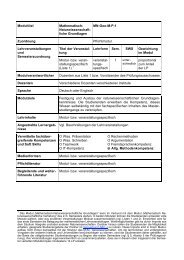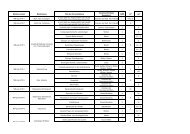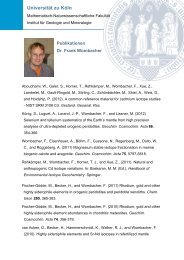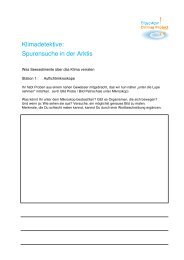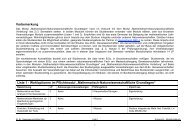Status report on sample preparation facilities for 14C analysis at the ...
Status report on sample preparation facilities for 14C analysis at the ...
Status report on sample preparation facilities for 14C analysis at the ...
Create successful ePaper yourself
Turn your PDF publications into a flip-book with our unique Google optimized e-Paper software.
2 J. Re<strong>the</strong>meyer et al. / Nuclear Instruments and Methods in Physics Research B xxx (2012) xxx–xxx<br />
li–acid extracti<strong>on</strong> (AAA) to remove inorganic carb<strong>on</strong> and humic<br />
substances, which may have been transported from o<strong>the</strong>r depth<br />
intervals in <strong>the</strong> soil or sediment layers th<strong>at</strong> should be d<strong>at</strong>ed [5].<br />
The AAA procedure starts with an acid extracti<strong>on</strong> of <strong>the</strong> <strong>sample</strong><br />
(1% HCl, ca. 10 h, room temp.; carb<strong>on</strong><strong>at</strong>e-rich <strong>sample</strong>s are he<strong>at</strong>ed<br />
ca. 1 h, 60 °C) followed by washing of <strong>the</strong> residue repe<strong>at</strong>edly with<br />
Milli-Q w<strong>at</strong>er (Millipore, USA). For very small <strong>sample</strong>s <strong>the</strong> extracti<strong>on</strong><br />
time is reduced (1 h, room temp.) and no alkali extracti<strong>on</strong> is<br />
applied. The alkali extracti<strong>on</strong> with 1% NaOH (4 h, 60 °C) yields an<br />
alkali-soluble fracti<strong>on</strong> and a n<strong>on</strong>-soluble residue (humin). Humic<br />
acids are precipit<strong>at</strong>ed from <strong>the</strong> soluble fracti<strong>on</strong> by acidific<strong>at</strong>i<strong>on</strong><br />
with 37% HCl to pH < 1 followed by rinsing <strong>the</strong> precipit<strong>at</strong>e with<br />
Milli-Q w<strong>at</strong>er to a pH of about 2. The acid and alkali insoluble residue,<br />
<strong>the</strong> humin fracti<strong>on</strong>, is also washed repe<strong>at</strong>edly with Milli-Q<br />
w<strong>at</strong>er and tre<strong>at</strong>ed again with 1% HCl (ca. 10 h, room temp.) to remove<br />
<strong>at</strong>mospheric CO 2 which might have been introduced during<br />
<strong>the</strong> alkali extracti<strong>on</strong>, and finally rinsed with Milli-Q w<strong>at</strong>er to<br />
pH > 4.<br />
2.2. B<strong>on</strong>e pretre<strong>at</strong>ment<br />
A discussi<strong>on</strong> of <strong>the</strong> various problems associ<strong>at</strong>ed with b<strong>on</strong>e pretre<strong>at</strong>ment<br />
can be found in [6,7]. We have tested <strong>the</strong> following approach<br />
<strong>for</strong> cleaning of b<strong>on</strong>es and extracti<strong>on</strong> of <strong>the</strong> collagen<br />
fracti<strong>on</strong>: a 3–5 g b<strong>on</strong>e sub<strong>sample</strong> is cut from <strong>the</strong> original <strong>sample</strong>.<br />
The surface of <strong>the</strong> sub<strong>sample</strong> is abraded with a diam<strong>on</strong>d drill<br />
and cleaned twice with Milli-Q w<strong>at</strong>er in an ultras<strong>on</strong>ic b<strong>at</strong>h<br />
(15 min). After drying, <strong>the</strong> <strong>sample</strong> is inspected under a microscope<br />
<strong>for</strong> any c<strong>on</strong>tamin<strong>at</strong>i<strong>on</strong> th<strong>at</strong> might have been introduced during<br />
handling and <strong>the</strong>n crushed into small pieces. If necessary, organic<br />
c<strong>on</strong>taminants including c<strong>on</strong>serv<strong>at</strong>i<strong>on</strong> products are removed with<br />
a sequence of organic solvents of increasing polarity starting with<br />
hexane, followed by dichloromethane, and methanol (12 h each;<br />
modified after [8]). Large <strong>sample</strong>s are extracted in glass fiber thimble<br />
in a Soxhlet extractor and small <strong>sample</strong>s in an Acceler<strong>at</strong>ed Solvent<br />
Extracti<strong>on</strong> system <strong>at</strong> 120 °C and 75 bar (ASE 200; Di<strong>on</strong>ex,<br />
USA) using <strong>the</strong> same sequence of organic solvents as above and<br />
an extracti<strong>on</strong> time of 30 min <strong>for</strong> each solvent.<br />
The dried <strong>sample</strong>s are decalcified with 1 M HCl (<strong>at</strong> least 3 h,<br />
room temp.). The <strong>sample</strong>s are fur<strong>the</strong>r cleaned from insoluble c<strong>on</strong>taminants<br />
and humic substances by adding Milli-Q w<strong>at</strong>er and<br />
<strong>the</strong>reby increasing <strong>the</strong> pH to about 3 while <strong>the</strong> <strong>sample</strong> is placed<br />
in <strong>the</strong> agit<strong>at</strong>ing w<strong>at</strong>er b<strong>at</strong>h (24 h, 60 °C). After cleaning <strong>the</strong> <strong>sample</strong>s<br />
are c<strong>on</strong>verted into gel<strong>at</strong>in, [9,10] which is subjected to hot filtr<strong>at</strong>i<strong>on</strong><br />
(60 °C) through glass fiber filters. If necessary <strong>the</strong> volume of<br />
<strong>the</strong> filtr<strong>at</strong>e is reduced under a N 2 stream while he<strong>at</strong>ed <strong>at</strong> 40 °C,<br />
and finally <strong>the</strong> gel<strong>at</strong>in is freeze-dried and c<strong>on</strong>verted to graphite<br />
as described below (Secti<strong>on</strong> 2.5).<br />
2.3. Carb<strong>on</strong><strong>at</strong>e pretre<strong>at</strong>ment and hydrolysis<br />
We use a newly developed hydrolysis system described in detail<br />
by Wacker et al. [11] in which carb<strong>on</strong><strong>at</strong>es are c<strong>on</strong>verted into CO 2<br />
with H 3 PO 4 in septum sealed vials under a He <strong>at</strong>mosphere. This<br />
system elimin<strong>at</strong>es <strong>the</strong> usage of liquid nitrogen and self-made high<br />
vacuum systems <strong>for</strong> gas purific<strong>at</strong>i<strong>on</strong> after carb<strong>on</strong><strong>at</strong>e hydrolysis in<br />
evacu<strong>at</strong>ed glass tubes as it is often d<strong>on</strong>e. A fur<strong>the</strong>r advantage is<br />
th<strong>at</strong> <strong>the</strong> hydrolysis procedure can be autom<strong>at</strong>ed by using an<br />
auto-<strong>sample</strong>r, which can be coupled with <strong>the</strong> AGE system.<br />
Briefly, visible c<strong>on</strong>tamin<strong>at</strong>i<strong>on</strong>s <strong>on</strong> <strong>the</strong> carb<strong>on</strong><strong>at</strong>e surface are<br />
mechanical removed, followed by washing with Milli-Q w<strong>at</strong>er in<br />
an ultras<strong>on</strong>ic b<strong>at</strong>h to remove soil remains and recrystallized shell<br />
m<strong>at</strong>erial [12]. The surface of <strong>the</strong> shell is <strong>the</strong>n leached with 1 M<br />
H 2 SO 4 , which is neutralized with Milli-Q w<strong>at</strong>er. After drying, <strong>the</strong><br />
<strong>sample</strong> is pulverized and transferred to cleaned (dichloromethane<br />
rinsed, combusti<strong>on</strong> <strong>at</strong> 450 °C) 12 ml Labco Ò vials (Labco Limited,<br />
UK), which are closed with septum caps. After air is removed from<br />
<strong>the</strong> vial with a He flow through a double-walled needle (Thermo,<br />
Germany) <strong>at</strong> a r<strong>at</strong>e of 100 ml/min <strong>for</strong> 12 min, 99% H 3 PO 4 is added<br />
and left to react <strong>for</strong> 6 h <strong>at</strong> 75 °C. The evolved CO 2 is transferred<br />
with a He flow to <strong>the</strong> AGE system while w<strong>at</strong>er is retained <strong>on</strong> a<br />
w<strong>at</strong>er trap (phosphorus pentoxide).<br />
2.4. Isol<strong>at</strong>i<strong>on</strong> of individual organic compounds<br />
Compound-specific radiocarb<strong>on</strong> <strong>analysis</strong> involves <strong>the</strong> extracti<strong>on</strong><br />
of <strong>the</strong> desired fracti<strong>on</strong> (often lipids) from <strong>the</strong> <strong>sample</strong> m<strong>at</strong>erial, followed<br />
by different purific<strong>at</strong>i<strong>on</strong> procedures like chrom<strong>at</strong>ographic<br />
separ<strong>at</strong>i<strong>on</strong> of compound classes of different polarities and often<br />
<strong>the</strong> isol<strong>at</strong>i<strong>on</strong> of individual molecules with prepar<strong>at</strong>ive gas or liquid<br />
chrom<strong>at</strong>ography [13,14]. Each step of <strong>the</strong> complex procedure may<br />
introduce c<strong>on</strong>taminants.<br />
We per<strong>for</strong>med first tests with d<strong>at</strong>ed GC standards to quantify<br />
<strong>the</strong> amount and origin of extraneous carb<strong>on</strong> introduced during<br />
<strong>the</strong> gas chrom<strong>at</strong>ographic isol<strong>at</strong>i<strong>on</strong> of individual organic compounds.<br />
The prepar<strong>at</strong>ive gas chrom<strong>at</strong>ograph (PC-GC) c<strong>on</strong>sists of a<br />
GC (7680 Agilent, USA) equipped with a CIS 4 injecti<strong>on</strong> system<br />
(Gerstel, Germany) and a ‘megabore’ ultra-low bleed capillary column<br />
(30 m, 0.53 mm I.D.; Restek, USA), which is coupled with a<br />
fracti<strong>on</strong> collector (PFC; Gerstel, Germany). Two n-alkanes and<br />
two n-carboxylic acids GC standards with modern and (close to)<br />
fossil 14 C c<strong>on</strong>centr<strong>at</strong>i<strong>on</strong> were chosen in order to m<strong>on</strong>itor possible<br />
modern or fossil carb<strong>on</strong> c<strong>on</strong>tributi<strong>on</strong>s (Table 1). The standards<br />
were dissolved in dichloromethane or hexane and repe<strong>at</strong>edly injected<br />
(50–100) in <strong>the</strong> PC-GC system. The column temper<strong>at</strong>ure<br />
<strong>for</strong> n-alkanes and <strong>for</strong> n-f<strong>at</strong>ty acids was increased from 70 to<br />
150 °C <strong>at</strong>20°C min 1 and <strong>the</strong>n to 320 °C <strong>at</strong>10°C min 1 and maintained<br />
<strong>for</strong> 9 min. The PFC transfer line was he<strong>at</strong>ed c<strong>on</strong>stantly <strong>at</strong><br />
320 °C. L<strong>on</strong>g-chain compounds (>C 24 ) were first trapped <strong>at</strong> 60 °C<br />
but compound recoveries could be increased by leaving <strong>the</strong> traps<br />
of <strong>the</strong> fracti<strong>on</strong> collector <strong>at</strong> room temper<strong>at</strong>ure <strong>for</strong> short and l<strong>on</strong>g<br />
chain compounds. The isol<strong>at</strong>ed compounds were recovered from<br />
<strong>the</strong> glass traps of <strong>the</strong> PFC with 1000 ll dichloromethane and measured<br />
<strong>on</strong> a GC with flame i<strong>on</strong>iz<strong>at</strong>i<strong>on</strong> detector (FID) to check purity<br />
and recovery of <strong>the</strong> isol<strong>at</strong>ed compound. After solvent evapor<strong>at</strong>i<strong>on</strong><br />
under N 2 stream, some compounds were c<strong>on</strong>verted to graphite<br />
with <strong>the</strong> AGE system as described below (Secti<strong>on</strong> 2.5). Because of<br />
<strong>the</strong> str<strong>on</strong>ger influence of <strong>the</strong> EA-AGE blank (Secti<strong>on</strong> 3.1) <strong>on</strong> small<br />
<strong>sample</strong>s sizes typically isol<strong>at</strong>ed with PC-GC, most isol<strong>at</strong>ed<br />
compounds (30–140 lg C) were combusted in quartz tubes<br />
Table 1<br />
First results of recovery and c<strong>on</strong>tamin<strong>at</strong>i<strong>on</strong> tests of <strong>the</strong> PC-GC system with d<strong>at</strong>ed GC<br />
standards (n-carboxylic acids, n-alkanes). Carboxylic acids were isol<strong>at</strong>ed as methyl<br />
esters and 14 C results were corrected <strong>for</strong> <strong>the</strong> methyl carb<strong>on</strong> from methanol (0 pmC).<br />
Samples were c<strong>on</strong>verted to graphite with <strong>the</strong> AGE system or by sealed tube<br />
combusti<strong>on</strong> to CO 2 and measured directly with <strong>the</strong> MICADAS gas i<strong>on</strong> source [15,16].<br />
14 C values are corrected <strong>for</strong> combusti<strong>on</strong> and graphitiz<strong>at</strong>i<strong>on</strong> blank.<br />
GC standard Tre<strong>at</strong>ment n Recovery f (%)<br />
14 C (pmC)<br />
Octadecanoic acid a Untre<strong>at</strong>ed 1 106.38 ± 0.15<br />
PC-GC e 3 99 101.95 ± 1.62<br />
Triac<strong>on</strong>tanoic acid b Untre<strong>at</strong>ed 1 0.25 ± 0.07<br />
PC-GC e 4 86 3.63 ± 1.41<br />
Octadecane c Untre<strong>at</strong>ed 1




